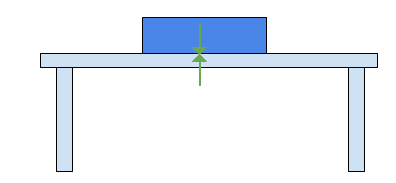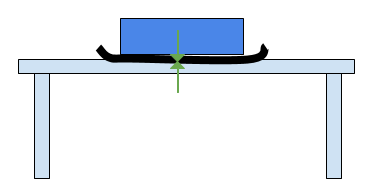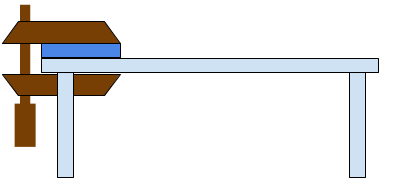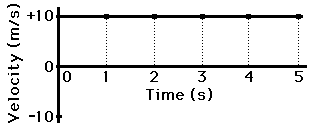-
Posts
2619 -
Joined
-
Days Won
21
Content Type
Profiles
Forums
Events
Everything posted by Ghideon
-
I think I'm not fully following the reasoning, can you elaborate? How is there a failure of Newton's third law?
-
Sometimes the following distinction may help: what do we need to know to find an actual action/reaction pair vs. what do we need to know find the magnitude of the force. Let’s try to stay simple and use example from previous diagram, I’ll do it without math this time*. Using the picture we ask two separate questions: 1: “Can you find an action/reaction pair of forces involving the book and the table?” I could answer something like “There is contact force between the table and the book. The book presses down on the table with some unknown force and the table pushes back with an equal and opposite force directed up. The upwards force is called normal force.” Note that there is no reference to gravity, it is not needed to find the action/reaction pair and not included since it is not part of the action/reaction pair. Let’s add the second question: 2: “The mass of the book is m. What is the magnitude of the action and reaction force in question 1?” Answer is “mg”. Now I have to know the mass and assume that gravity is causing the force down. But that does not change my first answer for the action/reaction pair. Now let’s add an analogy to further illustrate the difference between the action/reaction and gravity in this example. We put a black piece of paper between the book and the table. The paper’s mass is low and considered zero in this discussion. What is the action/reaction force between the paper and the table? The answer is pretty much the same as above “The paper presses down on the table with some unknown force and the table pushes back with an equal and opposite force directed up”. No reference to gravity. What is the magnitude of the force? Now things change. There is no way of telling the magnitude from looking at the table or the paper. We need to look at the mass of the book to get the answer “mg”. Last analogy for now: Let’s assume a very light book is clamped down to the table. The clamp’s pressure is high compared to the mass of the book so mass of book and clamp is neglected. Again, what is the action/reaction forces for book/table? Answer is same as in the first case: The book presses down on the table with some unknown force and the table pushes back with an equal and opposite force directed up. What is the magnitude of the force? Now we can’t use gravity at all, we have to get the force the clamp presses down with. Hopefully the above illustrates how one can look at the cause of some force vs the action and reaction pair some force causes. That is a valid point, I'll try to get time to do some example/comment that fits in the context of OPs question. *) Other members have already contributed good math, I’ll add formulas if requested.
-
Thanks for feedback on my post and for adding lots of interesting additional points! I’m trying to put together some clarifications and additional explanations for OP but I’m slightly more busy than usual at this time. Quick note for @joigus and others: The reason for introducing acceleration in my initial post was to illustrate my answer. I could have explained that better, I blame it on
-
@Theredbarron here is an idea how I think you could have formulated the initial question with lower risk of being dragged in an (unwanted) detailed discussion about the specific experiments. Hopefully this post helps OP in future topics and increase the odds for fruitful discussions*. I have an idea about doing some experiments in vacuum. Not just low pressure as on a mountain top or high up in the atmosphere, but vacuum. More specifically I wish to create, or get as close as possible, to the vacuum of space. Right now I have a meter. The best I manage to get to using my current equipment is a reading of 29 inch hg on the meter. How does my current meter reading compare to the vacuum of space? What difference would it make if I could reach a reading of 30; how much closer to the vacuum of space would a reading of 30 be? The above question is not intended to be the perfect vacuum question from engineering or scientific point of view, it’s just a variant on the initial question intended to help the formulation of future questions. The question intentionally still contains issues from OP regarding units, measurement relative to local atmospheric pressure etc, written from OPs point of view with the information available at that point. From this point there would still be lots of questions about the meter, units, issues with equipment and others but maybe less focus on the actual experiments. *) I've learnt some new things about vacuum measurements and units from this thread.
-
Emphasis mine One main thing in relativity is that there is no universal time. So unfortunately your understanding contradicts the current understanding of space and time as formulated in mainstream theories and supported by observations.
-
I'l try: The upward normal force from the table and the downward force due to gravity are two different forces acting on the same object. Action/reaction pair is the same force seen from two points of view. In the above case action/reaction could be seen as two separate action/reaction pairs: 1: Gravitational interaction Book-Earth and Earth-book 2: The books force pushing down on the table and the tables push on the book If everything is at rest then the forces will balance so numerical values of force due to gravity (1) and normal force (2) are same. Now try a case where 1 and 2 are not balaning each other: Accelerate the table upwards (for instance in an accelerating elevator). Then the normal force would change but gravity remains the same. (1) is still action/reaction pair and (2) is still action/reaction pair but (1) and (2) does not balance out.
-
It may or may not be important. Hopefully that answers the question. Analogy: If I ask you "is it important if the oil pressure changes from 60 to 70 PSI?" You might want to know if I speak about a car engine, truck engine or a top fuel dragster engine. And maybe if engine was idling, warm, cold, brand new or old. Or if there are a change in engine noise or change in exhausts. What fuel the engine runs on may make a difference etc. The point is that not only was more context needed to give a meaningful answer, the discussion could be more interesting as well. Having enough context so that those involved in the discussion can apply whatever knowledge they posses is important. Otherwise the discussion will be like: -"Hello, how important is it to lower the oil pressure from 70 to 55 PSI?" -"It depends" -"Ok, thanks, bye" I think @strange answered: According to the references at https://en.wikipedia.org/wiki/Vacuum that pressure translates into one cubic meter occupied by approximately one or a few molecules of matter. (I don't think the differences between Interplanetary space, Interstellar space, Intergalactic space will matter much in this discussion)
-
Does that imply that you first create a vacuum and then add gas? Is the outcome you expect/predict that the added gas will not be equally distributed but instead cling to the rotating wheel? If so you may think about placement of the gauge if you have a single, or if more than one gauge is required. Sorry if I'm misinterpreting the experimental setup.
-
Maybe you can post one of the answers from the other sites here? Then I might learn more abut how to interpret the question and what is an acceptable answer, at least according to you.
-
My best guess is that the vacuum required depends on what kind of physical force that is going to move the matter in the jar and what claims you are looking to support. You need "enough vacuum" to remove any doubts regarding the effect. You want to reduce the possibility that the matter is indeed moved by remaining air (=fan) instead of the effect you are looking for. One way of initial testing might be to run the experiment at lower and lower pressure and see how it affect the outcome and how it matches your prediction and expectations. Does something special happen when you get close to 30 that makes you expect a significantly improved result at for instance 29? Are you looking for some radiation pressure effect? Static electricity? Other? At the scale of planetary systems I guess gravity is the dominant force.
-
Hello. Not sure I understand your question but here is an attempt, also using geometry. I'll try to include your note regarding the sum v+v+v... If you have a constant velocity v and plot a graph you could think of the distance s as the area under graph. A numerical example: So to calculate the distance we could use multiplication 5*10=50 in this case (5 seconds of 10m/s velocity) or we could just use sum 10+10+10+10+10=50. Numerical result is the same. But I think the physical result is different. Le's take a to take a look at the units. Velocity is m/s and time is in seconds. If we just add velocities 10+10+... We have, physically, an increase in speed from 10 m/s to 50 m/s. So for the sum to physically get the correct result, the distance, we need to include the multiplications: 10*1 + 10*1 +...=50. Or with units spelled out: 10 m/s *1s + 10 m/s *1s +...=50m. Side note: When stating v+v+v+v... maybe you are looking for https://en.wikipedia.org/wiki/Integral ?
-
I don't know hat papers you have studied so far but here is one test where Oeffner and Lauder at Harvard used a robotic device to allow for dynamic and controlled conditions: http://www.people.fas.harvard.edu/~glauder/reprints_unzipped/Oeffner.Lauder.2012.pdf
-
That's no problem; then we are on the same level, compared to the real experts engaged in this thread. Ok. Then you might want to post a revised version of the paper? It's hard to avoid discussing Big Bang when the paper can be correct only if big bang model is incorrect. Anyway, let's try postpone big bang discussion and try another angle then: Can you explain the mathematical details how you get the number 1.8 billion light years? Where is this center from our point of view at this time? Can you show how you derive that? Since you use "c" can I, for further questions, assume you mean the speed of light in vacuum? I do not have a Masters degree in Physics from the university. I am hopefully not disqualified from chatting about your ideas. *) assuming you use c to mean the speed of light in vacuum.
-
Does the time dilation for observers in relative motion in a flat Minkowski spacetime count as an example?
-
"Using pseudoscientific concepts to get unscientific results about a fringe topics" It could sound like: "Psychic powers positively probed the anti gravity field, hence sub quark structures absolutely exists."
-
@william1952 In the meantime, here is a paper that could be a starting point for further reading: "On the dimensionality of spacetime". https://space.mit.edu/home/tegmark/dimensions.pdf The paper explains how there are issues with any idea that requires another number of dimensions than 3+1. The paper also provides references for further reading.
-
I had expected some more rigorous descriptions. I'll try some more questions to clarify and continue the reasoning and comparison with mainstream science: The paper: From explanation: -What experiment do you suggest that will reveal that there was a closed, continuous (simple) 4 dimensional space and that it was filled with a fluid (ether) before time t0? -What is time t0 in your idea in comparison to the Big Bang model? Note that the Big Bang model does not reach back to time t=0. Big Bang does not explain what happened at times before approx t=10−43 s The paper: From explanation: -Big bang is not a model of an explosion. How would you prefer to rewrite the paper so that it is not incorrect? -What observations or experiments would reveal the blast wave? -Since you are claiming an explosion and not expansion are you suggesting that universe does not expand? -Where is the blast wave and Active Layer at this time in relation to our universe?
-

Did anybody hear /read about Dr. Stephen M.Phillips?
Ghideon replied to Alexander1304's topic in Speculations
Comment on the original topic in the context of later material added by @jamesd1 From Dr. Phillip's writings about sacred geometry: https://noe-theory.com/wp-content/uploads/2017/06/Article05.pdf In Book ESP of Quarks and Superstrings micro-PSI is defined as some kind of ESP: (extract available on google books) If the pseudo/unscientific concept of sacred geometry is investigated by, or requires usage of, yet another pseudo/unscientific concept (PSI/ESP) the double use of pseudo/unscientific does not result in science. The result is probably better described as: -
Is this a response to one of my questions? Without quote it's tricky to see. Big Bang was not an explosion. Big Bang model does not have a center. Big Bang has no outside where a medium could exist. No medium supports a speed of sound that equals speed of light in vacuum (c). Ether is not part of Big Bang model. Can you point at something that is not in conflict with established theories?
-

Did anybody hear /read about Dr. Stephen M.Phillips?
Ghideon replied to Alexander1304's topic in Speculations
I would prefer just one paper with a viable model and evidence from supporting observations instead of a list with 100+ papers and unsupported claims. Just for fun I checked one and tracked the references to one Dr Adrian Parker, Professor Emeritus in Psychology, University of Gothenburg (https://psy.gu.se/personal?userId=xparad). As far as I can tell that only shows that there are psychological aspects of various phenomena* that could be investigated scientifically. Which of course may lead to interesting discoveries in physiology and without doubt absolutely zero evidence for Psi Phenomena. Note: I do not question existence peer reviewed papers about psychic powers*. I question existence of peer reviewed paper about psychic powers contains evidence supported by observations repeated by others and a model. I consider myself rather open-minded when new models and supporting evidence and observations are presented. In this case I did not have ot spend a lot of time before deciding for a proper name. Nothing presented so far about the works of mr Phillips will change that fact. I tried to see what a large online book provider's algorithm would suggest as alternatives if I visited mr Philips books. Result: Proof of Heaven A Guide to Spiritual Enlightenment Lessons Learned from the Afterlife Unity of Consciousness and Existence Incredible True Stories of Heavenly Encounters and the Afterlife Real Magic My opinion: pseudo/non-scientific is a reasonable name to use. *) Psi Phenomena or other. -
Ok, good point. I'll continue my naive thoughts and try even bigger then: the Big Rip. Assume the Big Rip model correctly describes the future of the universe. The whole universe needs to reach some specific state before being able to destroy very small and stubborn particles. How does that count? (About 50% serious / 50% joke)
-

Did anybody hear /read about Dr. Stephen M.Phillips?
Ghideon replied to Alexander1304's topic in Speculations
Silence from mainstream scientists automatically means that pseudo/non-scientific material is true? That does not sound plausible or logic. From the promotional link above https://th_*_hy.world/encyclopedia/occult-chemistry (emphasis mine) I think we need evidence and a model for ESP before it can be used as an explanation for anything? -

gravity can pull us through the cosmos to where we want to go
Ghideon replied to farsideofourmoon's topic in Relativity
Gravitational slingshot have been used for quite some time, for instance to accelerate Voyager probes. It's a useful idea, at least to accelerated in solar system*. https://en.wikipedia.org/wiki/Gravity_assist I do not know what "lock on to gravity waves" means. But exceeding the speed of light in vacuum, gravitationally assisted or not, is not possible in any accepted mainstream theory AFAIK. *) Of course it works outside solar system as well but I do not think the time scales are practical. -
Hello. I have a few initial questions about the attached paper Are there any observations or evidence supporting the above initial condition? Can you describe the time scale of events in your idea? Where was the center of the explosion? How does it settle into a layer? What is the speed of sound? What medium is the speed measured in? Note: Since the big bang model in mainstream science is not a explosion I can't compare your idea to that. It looks like you use the name "Big Bang" for something that does not have anything in common with the big bang model https://en.wikipedia.org/wiki/Big_Bang





